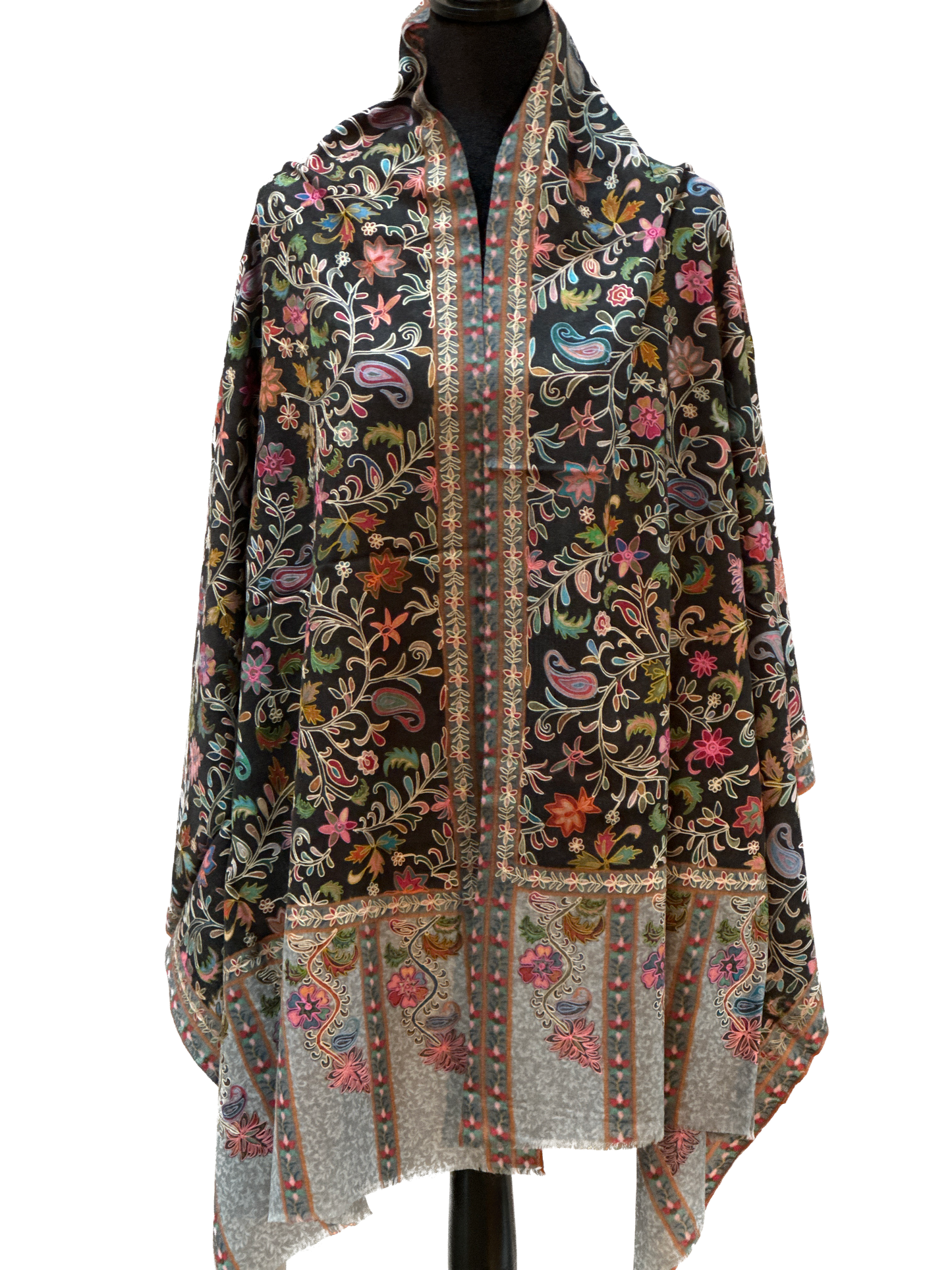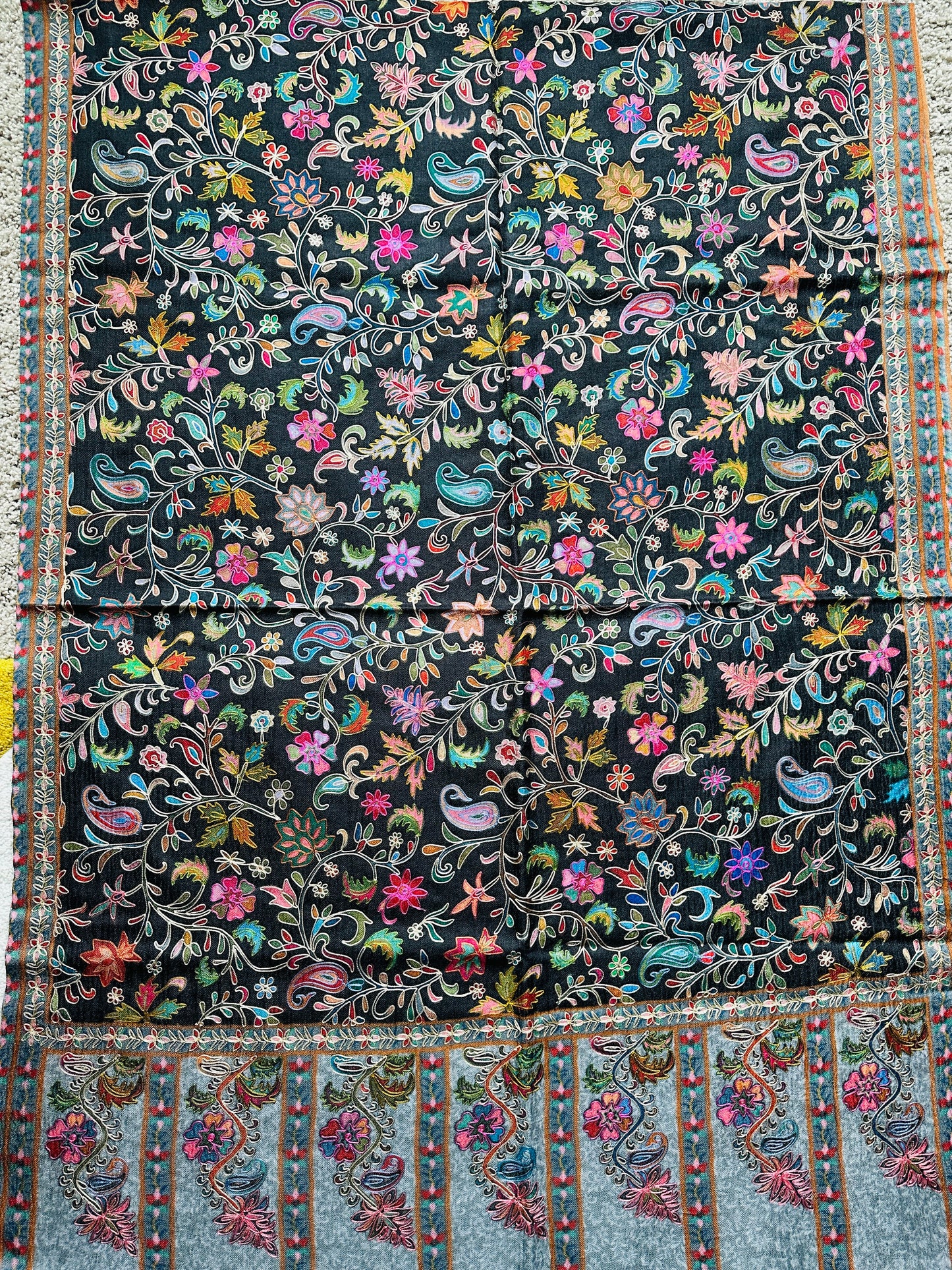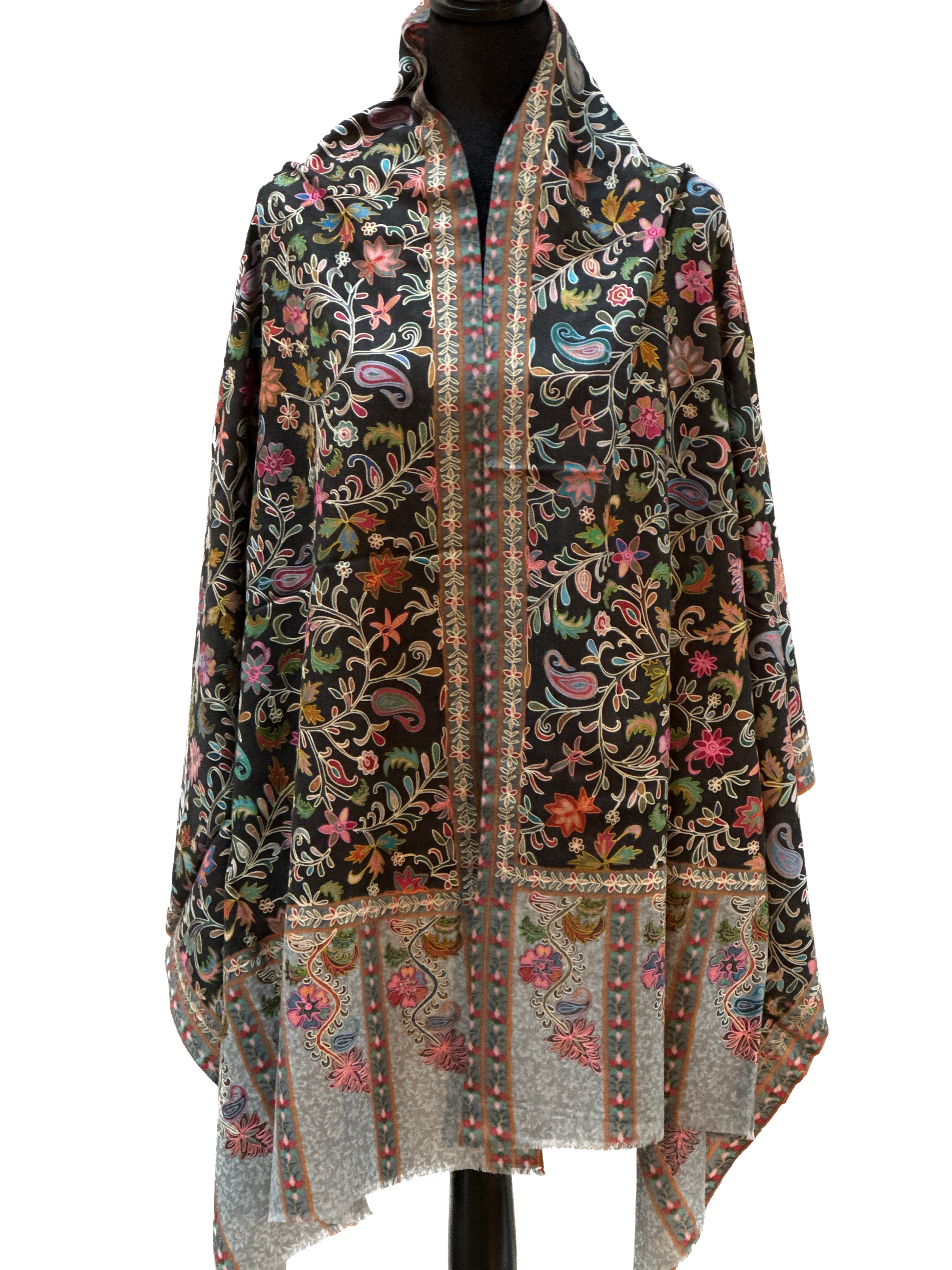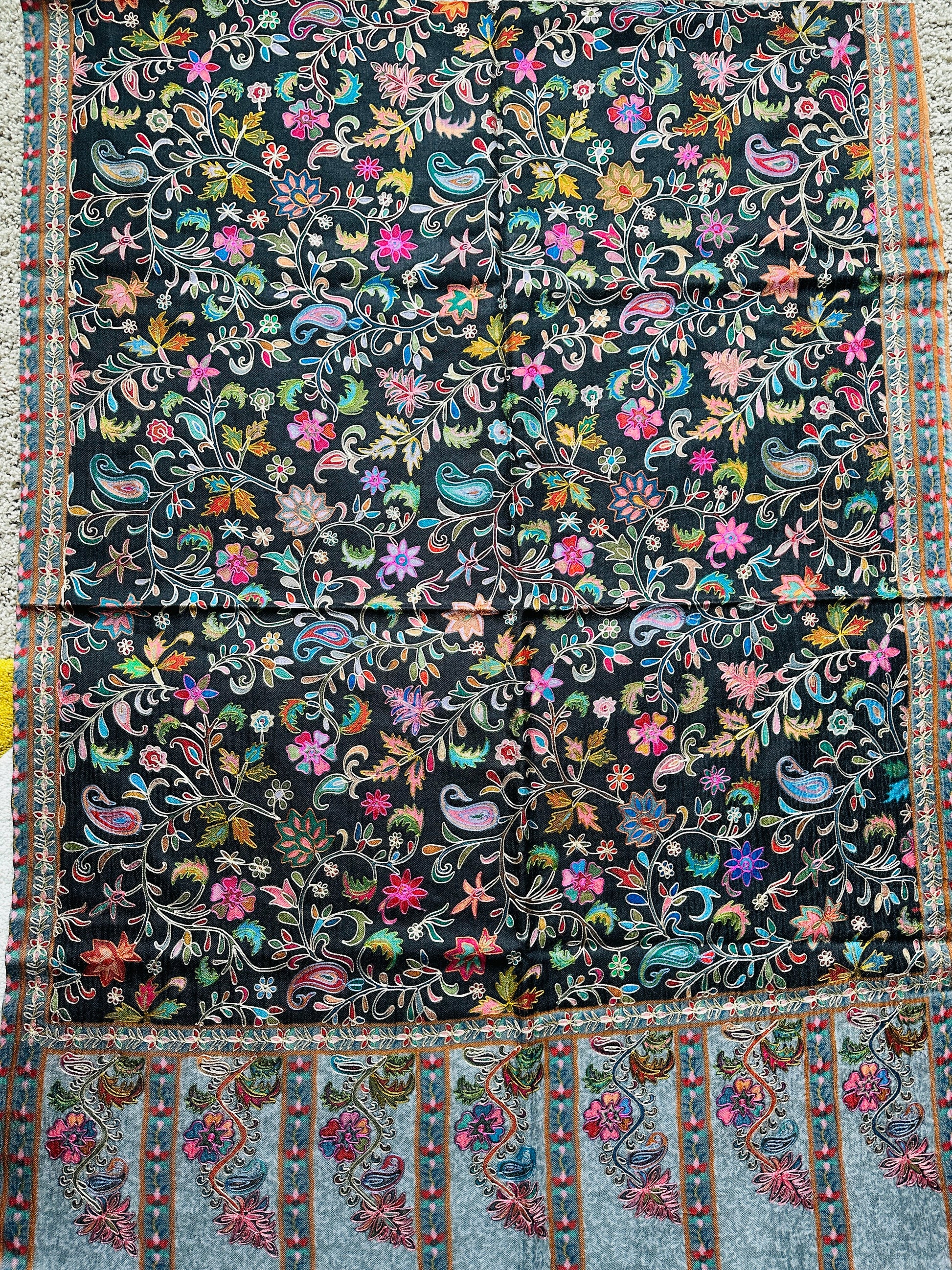Alamode Vista
Kalamkari Design Pashmina Wool Shawl - Black
Kalamkari Design Pashmina Wool Shawl - Black
Couldn't load pickup availability
Share
Hand-Painted Handloomed Pashmina Shawl, a masterpiece adorned with intricate Kalamkari hand embroidery using luxurious silk threads.
Crafted with precision on traditional handlooms, this shawl features the finest Pashmina wool, celebrated for its unmatched softness and warmth. It's not just an accessory; it's a luxurious embrace that adds both comfort and sophistication to your ensemble.
What truly sets this shawl apart is the captivating hand-painted design enriched with Kalamkari hand embroidery using sumptuous silk threads. Each silk stitch and hand-painted stroke is a testament to the artisan's skill and creativity, bringing to life a canvas of artistry and tradition.
Drape it elegantly over your shoulders or wear it as a wrap; our Artistic Hand-Painted Handloomed Pashmina Shawl is a statement piece that infuses culture and individuality into your style. It's more than just a fashion choice; it's a wearable work of art that celebrates the harmonious blend of heritage and contemporary elegance.
Experience the luxurious comfort of Pashmina, the exquisite beauty of silk thread embroidery, and the artistic allure of Kalamkari with this extraordinary shawl. Elevate your fashion statement and embrace the opulent charm of our Artistic Hand-Painted Handloomed Pashmina Shawl.
Disclaimer: Colour of the actual product may vary from the image. These are made to order designer styles, hence expect a slight variation from the image displayed.
What is Kalamkari?
The word Kalamkari comes from two different words 'Kalam' meaning 'Pen', and 'Kari' meaning 'work'. Hence Kalamkari literally means the work of the pen. A kalamkari is an art form, which includes drawing with a pen on fabric with hands; using a brush and a few natural dyes. Kalamkari art is common in Isfahan (Iran), and in India, in the states of Andhra Pradesh and Telangana. They use plant-based paints and dyes, and a naturally made bamboo brush, and handcraft brilliant motifs over the shawls. These shawls last long for generations to cherish.
Process of Kalamkari art
The extraordinary process of Kalamkari involves a total of 23 steps, before completion. Artisans execute it with the help of specialized pens, handcrafted from the bamboo tree, and paints or dyes which are organic. It is stringently forbidden to use chemical or synthetic dyes in Kalamkari art. Hand painting the textile is labyrinthine, but the results are totally worth the labour.
To start with, workers soak a shawl in astringent and buffalo milk. They then sun-dry the material. Later, the design is handmade in several stages and not all at one time. Workers use bamboo or date palm stick pens primarily to craft intricate and highly delicate details. As far as dyes are concerned, workers use various roots, seeds, plant leaves, crushed flowers to extract them. The colours chosen then are usually bright and brilliant. Artisans often choose red, yellow, green, blue in their vivid shades to craft a Kalamkari shawl.
What are Kalamkari Pashmina Shawls?
When it comes to Pashmina shawls, artisans from Kashmir too imbibed this beautiful craft in pure Pashmina shawls. After painting Pashmina shawls with Kalamkari, artisans here hand embroider around the motifs in black. This is another step, in addition to the 23 steps of Kalamkari. After artisans hand-paint motifs onto the surface of the shawl, they choose a matching or contrasting thread to outline these motifs. This too takes a lot of time, as Kashmiri Sozni Kars (artisans specializing in Sozni Kari), give attention to each detail and each motif closely. The final result of a Kalamka.ri and Sozni rendezvous is simply beyond comparison.
Styles to wear a Kalamkari shawl
Kalamkari shawls carry a detailed, intricate design. These feature magnificent art and flaunt-worthy motifs all over the base. Hence the styles to wear them usually include those where the base is pretty visible. Here are a few styles to wear a handmade Kalamkari Pashmina shawl
- Place it on your shoulders like a wrap, and bring the two sides to the front. This way the pattern on the shawl can be visible from two sides.
- Wear the shawl like a dupatta so that the patterns on the centre keep your front body covered, in a warm and elegant embrace.
- Let the shawl drape over one shoulder, thus showcasing its entirety, both from the front and back.
- Let the shawl drape loose from your forearm as if you are not wearing it, or are planning to wear it later.
- Wrapping the shawl around your body, too, makes sure to flaunt this luxury piece to the onlookers.
As the world’s most celebrated luxury fiber, people’s love with Pashmina has grown over the centuries. With its earliest documented use going back to years, it till today stands unchallenged as one of the most novel, sophisticated art that has made its way to the trousseau and wardrobes of the royals. Owing a Pashmina is a matter of pride, and it’s this exclusivity calls for suitable care and maintenance
Washing
Ideally, Pashmina should always be dry cleaned using organic solvents. It not only removes soil and stains from the fabric; but also maintains the shape, color, look of the garment. If that isn’t an option, use cold water to hand-wash your Pashmina in a separate container/bucket/sink. You may add a mild detergent such as baby shampoo, and make sure that it fully dissolves in water before you soak your garment in it. Later wash the Pashmina accessory softly while being extra careful of the hand-woven trusses.
To dry a Pashmina scarf, hang it out in shade, away from strong wind and let it dry-out slowly. Bigger/heavier garments can be kept it in a towel and rolled in to drench extra water before drying
Dry Cleaning
Pashmina is an unusual fabric that becomes softer with each use. With good care, you not only make it gentler to use but also add to the life of the garment. The fine weaving of Chyangra goats’ wool by Kashmiri artisans is an age-old tradition that brings out the best of Pashmina. Such a cloth must always be protected with the right care. It is advisable to dry clean the garment after a season’s use to maintain its durability. Natural wool and silk dry clean beautifully, helping to return your precious Pashmina to a "like-new" condition. It also prevents loss of color, and change of texture or finish due to extensive use
Storage:
- Store your Pashmina in a muslin cloth to avoid the development of lint or short fibers that separate the surface of cloth or yarn. Fold it neatly inside out in moth-proof stuff. Keep the Pashmina in a drawer or storage box with dried Azadirachta indica or Indian Lilac sachets or lavender sachets to repel moths. If you want to store your cashmere over a longer seasonal period, you can also consider getting plastic zip storage bags so that moths can’t penetrate it.
- Do not use naphthalene balls while storing the Pashmina as it can mar its beauty and give it a permanent smell.
- Keep your Pashmina at a cool, dry place. In case of contact with moisture, visit a dry cleaner to get the issue sorted.
- Aerate your cashmere articles periodically, preferably once a month to avoid moths in your exclusive Pashmina products
- Never expose your Pashmina to direct heat or extreme sunlight as it can damage the garment’s texture.
- Brush the shawl, scarf, or stole after every wear as they hoard dust easily.
- Many Pashmina accessories get passed on from one generation to another. To ensure yours does that too, allow the garment to go through professional restoration after every few years to maintain its newness.
- Never hang a Pashmina in the closet as it can cause the fabric to stretch and lose its shape. Instead, always fold and stack it neatly to keep the material crisp.
- In case your Pashmina develops a thread snag that is running across the fabric, take your fingernail and rub across the threads, kind of like you are scratching something. Of course, don’t make it too rough because you will make it worse. Just follow the link of that thread all the way to the end and clip it.
Taking care of your Pashmina is this simple. All you need to do is give it some attention while storing and washing, and the garment will remain fresh for the years to come



